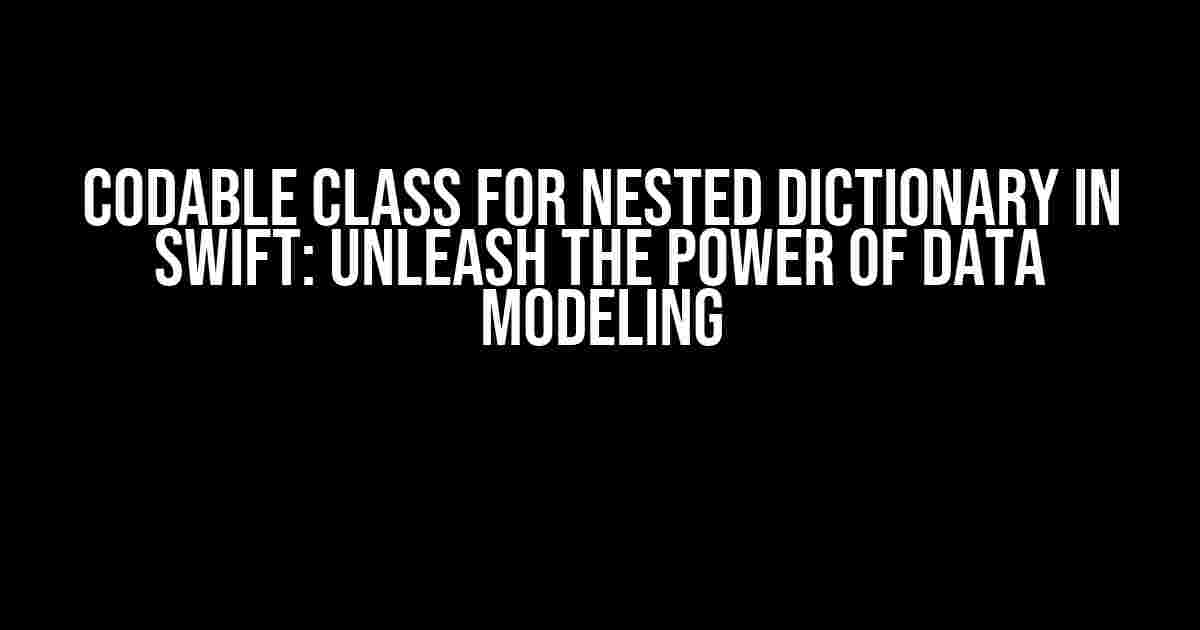As a Swift developer, you’ve likely encountered the need to work with nested dictionaries or JSON data. It’s a common scenario where you receive data from an API or backend service, and you need to parse it into a usable format. That’s where the Codable protocol comes in – a powerful tool for encoding and decoding data in Swift. In this article, we’ll explore how to create a Codable class for a nested dictionary in Swift, and unlock the full potential of data modeling.
Understanding the Problem: Nested Dictionaries and JSON Data
Nested dictionaries can be a challenge to work with, especially when it comes to parsing JSON data. Imagine receiving a response from an API that looks like this:
{
"data": {
"user": {
"name": "John Doe",
"age": 30,
"address": {
"street": "123 Main St",
"city": "Anytown",
"state": "CA",
"zip": "12345"
}
}
}
}How would you go about parsing this data into a usable format in Swift? That’s where our Codable class comes in.
Creating a Codable Class for a Nested Dictionary
To create a Codable class for a nested dictionary, we’ll start by defining our data model. Let’s create a `User` struct that represents the user data:
struct User: Codable {
let name: String
let age: Int
let address: Address
}The `User` struct conforms to the `Codable` protocol, which means we can use it to encode and decode data. Notice that we’ve also defined an `Address` struct as a nested property:
struct Address: Codable {
let street: String
let city: String
let state: String
let zip: String
}The `Address` struct also conforms to the `Codable` protocol, which allows us to encode and decode the nested address data.
Encoding and Decoding Data
Now that we have our data model defined, let’s see how we can use it to encode and decode data. We’ll start by encoding a `User` object:
let user = User(name: "John Doe", age: 30, address: Address(street: "123 Main St", city: "Anytown", state: "CA", zip: "12345"))
let encoder = JSONEncoder()
do {
let jsonData = try encoder.encode(user)
print(jsonData)
} catch {
print("Error encoding data: \(error)")
}This code encodes the `User` object into a JSON data representation. If we print the `jsonData`, we’ll see a JSON string that looks like this:
{
"name" : "John Doe",
"age" : 30,
"address" : {
"street" : "123 Main St",
"city" : "Anytown",
"state" : "CA",
"zip" : "12345"
}
}Now, let’s see how we can decode this JSON data back into a `User` object:
let decoder = JSONDecoder()
do {
let userData = try decoder.decode(User.self, from: jsonData)
print(userData)
} catch {
print("Error decoding data: \(error)")
}This code decodes the JSON data back into a `User` object, which we can then use in our Swift code.
Benefits of Using a Codable Class for Nested Dictionaries
So, why should you use a Codable class for nested dictionaries? Here are some benefits:
- Easy data modeling: With Codable, you can define your data model in a clear and concise way, making it easy to understand and maintain.
- Faster development: By using a Codable class, you can quickly encode and decode data, speeding up your development process.
- Improved data integrity: Codable helps ensure that your data is correctly formatted and validated, reducing the risk of errors and data corruption.
- Enhanced flexibility: With Codable, you can easily adapt to changes in your data model or API endpoint, making it easier to evolve your app over time.
Common Use Cases for Nested Dictionaries
Nested dictionaries are commonly used in various scenarios, including:
- API responses: When receiving data from an API, you may encounter nested dictionaries or JSON objects that need to be parsed.
- Data storage: In-app data storage solutions, such as Core Data or Realm, may use nested dictionaries to store complex data structures.
- Serialization: When serializing data to disk or transmitting it over a network, you may need to work with nested dictionaries or JSON objects.
- Data analytics: In data analytics and machine learning, nested dictionaries can be used to represent complex data structures, such as user behavior or event tracking.
Conclusion
In this article, we’ve explored how to create a Codable class for a nested dictionary in Swift. By using Codable, you can easily encode and decode data, and unlock the full potential of data modeling. Whether you’re working with API responses, data storage, serialization, or data analytics, a Codable class for nested dictionaries can help you simplify your code and improve your app’s performance.
Remember to keep your data model clean and concise, and don’t be afraid to get creative with your Codable classes. With practice, you’ll become a master of data modeling and processing in Swift!
| Property | Type | Description |
|---|---|---|
| name | String | The user’s full name |
| age | Int | The user’s age |
| address | Address | The user’s address information |
By following the instructions in this article, you should now have a solid understanding of how to create a Codable class for a nested dictionary in Swift. Happy coding!
Frequently Asked Question
Get to the bottom of creating a codable class for nested dictionary in Swift with these frequently asked questions!
What is the purpose of creating a Codable class for a nested dictionary in Swift?
Creating a Codable class for a nested dictionary in Swift allows you to easily encode and decode complex data structures, making it simple to work with JSON data or other external data sources. It also enables you to represent nested data in a more structured and accessible way.
How do I define a Codable class for a nested dictionary in Swift?
To define a Codable class for a nested dictionary, you need to create a struct or class that conforms to the Codable protocol. You then need to define the properties that correspond to the keys in your nested dictionary, making sure to use the correct types for each property. Finally, implement the required initializer and encode/decode methods.
How do I handle nested dictionaries with dynamic keys in my Codable class?
To handle nested dictionaries with dynamic keys, you can use a Dictionary
Can I use a single Codable class to decode multiple types of nested dictionaries?
Yes, you can use a single Codable class to decode multiple types of nested dictionaries by using an enum with associated values or a generic type. This allows you to define a single class that can handle different types of nested dictionaries, making your code more flexible and reusable.
What are some common pitfalls to avoid when creating a Codable class for a nested dictionary in Swift?
Some common pitfalls to avoid include forgetting to implement the required initializer and encode/decode methods, using the wrong types for properties, and not handling errors properly. Additionally, be careful when working with optional values and make sure to test your Codable class thoroughly with different types of input data.



